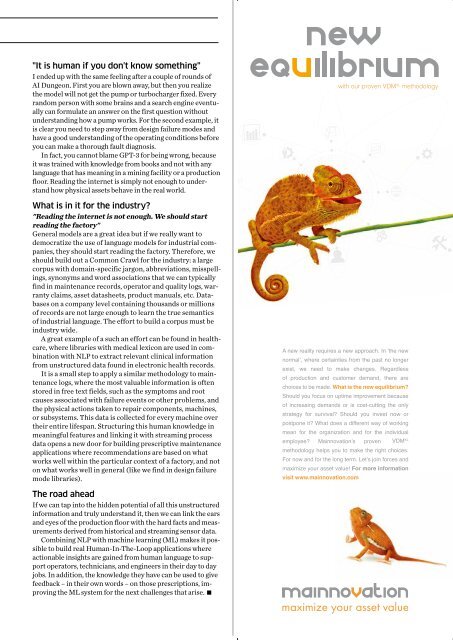Maintworld Magazine 3/2021
- maintenance & asset management
- maintenance & asset management
Create successful ePaper yourself
Turn your PDF publications into a flip-book with our unique Google optimized e-Paper software.
"It is human if you don't know something"<br />
I ended up with the same feeling after a couple of rounds of<br />
AI Dungeon. First you are blown away, but then you realize<br />
the model will not get the pump or turbocharger fixed. Every<br />
random person with some brains and a search engine eventually<br />
can formulate an answer on the first question without<br />
understanding how a pump works. For the second example, it<br />
is clear you need to step away from design failure modes and<br />
have a good understanding of the operating conditions before<br />
you can make a thorough fault diagnosis.<br />
In fact, you cannot blame GPT-3 for being wrong, because<br />
it was trained with knowledge from books and not with any<br />
language that has meaning in a mining facility or a production<br />
floor. Reading the internet is simply not enough to understand<br />
how physical assets behave in the real world.<br />
What is in it for the industry?<br />
"Reading the internet is not enough. We should start<br />
reading the factory"<br />
General models are a great idea but if we really want to<br />
democratize the use of language models for industrial companies,<br />
they should start reading the factory. Therefore, we<br />
should build out a Common Crawl for the industry: a large<br />
corpus with domain-specific jargon, abbreviations, misspellings,<br />
synonyms and word associations that we can typically<br />
find in maintenance records, operator and quality logs, warranty<br />
claims, asset datasheets, product manuals, etc. Databases<br />
on a company level containing thousands or millions<br />
of records are not large enough to learn the true semantics<br />
of industrial language. The effort to build a corpus must be<br />
industry wide.<br />
A great example of a such an effort can be found in healthcare,<br />
where libraries with medical lexicon are used in combination<br />
with NLP to extract relevant clinical information<br />
from unstructured data found in electronic health records.<br />
It is a small step to apply a similar methodology to maintenance<br />
logs, where the most valuable information is often<br />
stored in free text fields, such as the symptoms and root<br />
causes associated with failure events or other problems, and<br />
the physical actions taken to repair components, machines,<br />
or subsystems. This data is collected for every machine over<br />
their entire lifespan. Structuring this human knowledge in<br />
meaningful features and linking it with streaming process<br />
data opens a new door for building prescriptive maintenance<br />
applications where recommendations are based on what<br />
works well within the particular context of a factory, and not<br />
on what works well in general (like we find in design failure<br />
mode libraries).<br />
The road ahead<br />
If we can tap into the hidden potential of all this unstructured<br />
information and truly understand it, then we can link the ears<br />
and eyes of the production floor with the hard facts and measurements<br />
derived from historical and streaming sensor data.<br />
Combining NLP with machine learning (ML) makes it possible<br />
to build real Human-In-The-Loop applications where<br />
actionable insights are gained from human language to support<br />
operators, technicians, and engineers in their day to day<br />
jobs. In addition, the knowledge they have can be used to give<br />
feedback – in their own words – on those prescriptions, improving<br />
the ML system for the next challenges that arise.

















